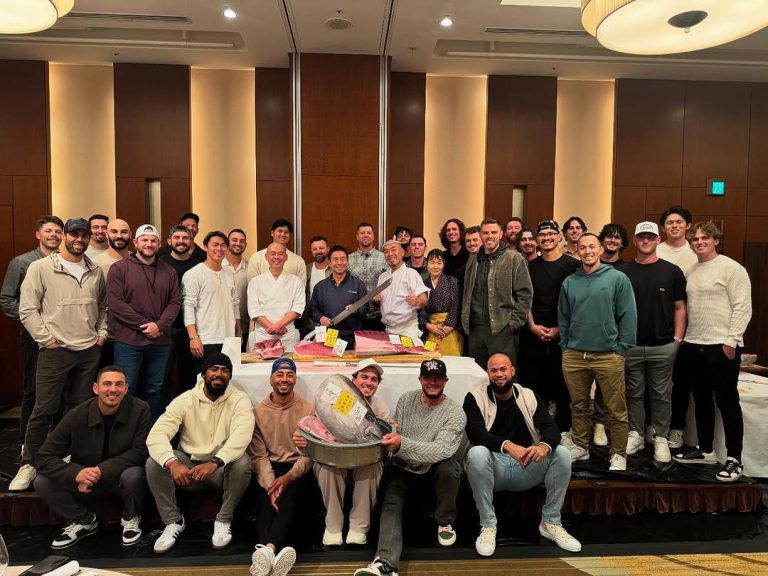
When a massive bluefin tuna sold in 2019 for a record-breaking $3.1 million at Tokyo’s then brand-new Toyosu fish market, it brought renewed attention to how extraordinarily valuable bluefin is. And renewed questions about the species’ survival.
The prized fish, which is a delicacy at sushi restaurants around the world, can cost diners anywhere from $10 to $200 per piece. High demand for bluefin tuna has led to a long history of overfishing and dangerously low numbers.

This is your guide to what the best sushi city in America has to offer, from the ultimate California roll to spectacular omakase.
And yet, after more than a decade of alarm-raising in the press and by conservation groups, plus an influential 2008 “60 Minutes” piece, if you go to most sushi bars in Los Angeles and around the world these days, bluefin tuna is served without apology to sushi connoisseurs who usually don’t decline the offer.
Dig deeper into the issue and you’ll find that conservation experts and sushi chefs have mixed opinions on whether folks should be eating bluefin tuna right now.
In other words: It’s complicated.
“It’s definitely the most important fish in sushi restaurants,” says Mark Okuda, chef and owner of the Brothers Sushi in Woodland Hills and Santa Monica. “Like beef patties to a burger shop, bluefin tuna is essential to sushi.”
Daniel Son, a second-generation sushi chef who plans to open a omakase restaurant, Sushi Sonagi, in Gardena in June, likens bluefin tuna to being the “main character” of sushi. “Everything sort of surrounds bluefin tuna,” says Son, who also owns Katsu Sando restaurants in Chinatown and San Gabriel. “It’s like, ‘When are you going to unleash the toro?’”
To the undiscerning eye, it might be confusing when bluefin tuna is listed on a menu. It goes by many names, including kuro maguro or hon maguro in Japanese. And similar to different grades of beef, like a round steak or ribeye, cuts of bluefin tuna also vary from the leaner akami sides of the fish to fattier toro belly sections.
Mostly consumed raw, bluefin tuna’s appearance can vary from a deep red to pinkish hue marbled with white, depending on the cut. At sushi restaurants, it’s served in a variety of ways: dry-aged, seared or marinated in a tempered soy sauce bath. Sushi chefs often wax poetic about its complex flavor profile.
“There’s so much depth in flavor, like umami, sweet, salty, sour and even bitterness from some of the blood,” said Son. “A bite from that fish can capture all those tastes in one. It’s also so texturally tender that you almost don’t even have to chew to eat it.”
As tethered as bluefin tuna is to sushi culture, it wasn’t always the culinary icon it is now. Sushi chefs in Japan began using the toro cuts of bluefin in the late 1950s, according to Trevor Corson’s book “The Story of Sushi: An Unlikely Saga of Raw Fish and Rice.” In the early 1970s, when beef became popular in Japan, the nation’s palate began to shift toward “strong flavors and dark flesh,” leading to an increased interest in bluefin tuna, according to Smithsonian Magazine. In the early 20th century, North Americans fished large bluefin tunas for sport, not consumption. Then there was a whole fishing industry dedicated to catching bluefin tuna so that it could be processed into cat and dog food.
Andre Boustany, the director of science for global ocean conservation at the Monterey Bay Aquarium, says fisheries were getting pennies on the pound for bluefin tuna in pet food operations. “It wasn’t even a high-value fishery, but they were still catching as many of them as they could,” Boustany says. “And then it was a double whammy when the market for sushi and international air travel expanded,” making it cheaper and easier to ship the fish.

International auctions have fetched as much as $3 million for prized bluefin tuna.
Bluefin tuna is an easy target for overfishing, chiefly because of its gargantuan size. The largest of all tuna, bluefin can live up to 40 years and weigh up to 2,000 pounds. “It’s like managing elephants versus trying to manage rats,” Boustany says. “Elephants are just going to be much more susceptible to hunting — and that’s kind of what bluefin tuna is like.”
There are three species of bluefin tuna — Atlantic, Pacific and Southern — and they’ve all been historically overfished. In 2010, the population of adult Pacific bluefin tuna dropped to as low as 1.5% of pre-fishing levels, before rising to 10% in 2020, according to a report. “So 10% is much better than 1.5%, but we’re still not out of the woods,” Boustany says.
The majority of bluefin tuna used in California is most likely the Pacific species because it’s caught along the coast, according to Boustany. But the bluefin tuna trade should be thought of as more of a web than anything else. For example, a lot of fish might come from the Mediterranean but go to Japan for processing before ending up in the United States, something called “reexporting.”
Monterey Bay Aquarium has been working in bluefin tuna research and conservation for more than two decades now. It hasn’t been easy to get the populations to a sustainable level because of the nature of these fisheries. Fish management measures can’t occur only on the national level, but also on the international level. “That requires getting a bunch of disparate actors in the room together and getting them to agree to anything,” Boustany says.
There has been tremendous progress in fish management in the last decade, with all bluefin tuna populations starting to increase. Still, Boustany says he’s only “cautiously optimistic,” as bluefin tuna are still being overfished and the populations are not at the level where they need to be yet.

Monterey Bay Aquarium’s Seafood Watch program, which provides global sustainability assessments on seafood for consumers, recommends that people avoid eating all bluefin tuna species regardless of whether they’re farmed or wild-caught. Its reports cover a variety of details, such as where and how bluefin tuna are caught. Some of the main reasons Seafood Watch says to avoid eating bluefin include the problems of overfishing and by-catches, a term that refers to fisheries incidentally also catching other important but non-target creatures from the food web of the ecosystem.
However, not all experts agree on this recommendation, such as Victor Restrepo, the International Seafood Sustainability Foundation’s vice president of science and chair of its scientific advisory committee. “I don’t think that people necessarily need to avoid bluefin tuna. They need to be more conscious about the decisions that they are making.”
Restrepo says that the three species of bluefin tuna have all been horribly mismanaged in the past. But now they’re managed by five tuna Regional Fisheries Management Organizations (RFMOs), which are following the best available scientific approaches. The RFMOs assess the bluefin tuna population statuses and intensity of fishing and measure whether fishing is sustainable or not. Then they manage the stocks in real time to obtain the maximum catches that won’t drive the populations to collapse.
Since bluefin tuna are long-lived, it might take some time before the world sees the effects of the current positive management of the fish. “Initially, it will allow for some low-level number of catches, and if that respects the management framework and the rebuilding plan for the population, then I consider those catches to be sustainable,” Restrepo says.
But there won’t be sushi for everybody. “It’ll be limited in amounts, but I think those are sustainable. And while all three populations are being sustainably managed now, it’ll take a long time for them to recover and to allow for the potential catches that could be a lot higher in the future,” Restrepo says.

What can be puzzling to the average consumer is the term “endangered” when it comes to bluefin tuna. Organizations like International Union for Conservation of Nature (IUCN) have previously labeled all three bluefin tuna species as endangered, with Southern bluefin tuna still under that distinction. However, bluefin tuna are not an endangered species under the U.S.’ Endangered Species Act.
“IUCN’s label of ‘endangered’ is to give people an indication that this is something that we should be aware of and this is something where we should focus conservation efforts, but it doesn’t really have any legal standing,” Boustany says. “So, it’s a different definition of ‘endangered.’”
Fishery management organizations operate using terms such as “overfished” and don’t assign “endangered” labels to bluefin tuna.
The label from the international conservation group is “ultra-precautionary,” Restrepo says. “It’s a very risk-based approach that was developed for giraffes and elephants — terrestrial mammals that have very small and fragile populations — but not for tunas, which are highly productive. I think that the IUCN criteria are not well suited to manage the tunas. The RFMO criteria are well suited to manage that. They’re two different things.”
So what should consumers do when it comes to bluefin tuna? In addition to sustainability issues, there are health concerns. Since bluefin tuna are a long-lived predatory and migratory species, the fish have high concentrations of neurotoxic methylmercury in their tissue, something that increases with age.
Don’t overdo it, some say. “I think anything in moderation is always great,” Son says. “You don’t eat a pound of sugar every day. That would be bad.”

Like conservation experts, sushi chefs have mixed opinions about whether to put it on their menus.
Okuda, who sources bluefin from Mexico, Spain and Japan, has been in the sushi industry for 25 years. He’s seen how fisheries have been using better technology to keep bluefin tuna more sustainable, especially in the last 10 to 15 years, something that has convinced him to continue offering it at the Brothers Sushi.
When Son and his father operated Kura Fine Japanese Cuisine in West Hollywood before it closed in 2019, they sourced their bluefin from a sustainable Japanese fish farm. (It farmed bluefin tuna using eggs hatched from Kindai University, meaning no bluefin tuna were removed from the wild population. Most bluefin tuna “farms” are actually ranched, meaning companies take bluefin tuna from the wild and move them to ocean pens and fatten them up there.)
As Son is gearing up to open Sushi Sonagi, he’s committed to not serving bluefin tuna until he feels there’s more positive information out there about its sustainability.
Bluefin tuna is Son’s favorite fish, but he thinks there are plenty of other fish in the sea to offer to customers. “At the end of the day, the chefs are the ones who are creating the menu and we do have some power,” Son says. “I don’t criticize any sushi chef that has bluefin on the menu. They’re not breaking any laws, and we’re only using what’s available to us. But I do think it can be a great opportunity for a lot of chefs to be creative and move away from bluefin tuna to let other fish shine.”
Boustany, who stands by Monterey Bay Aquarium’s Seafood Watch recommendation to avoid all bluefin tuna, tells diners to not order it, at the very least. “If they want to be a little bit more active about sustainable seafood, then they could mention it to the chef or their waiter that bluefin tuna is not sustainable at this moment,” he says.
Sushi Watch: The Aquarium’s Guide
The Monterey Bay Aquarium ranks farmed and fished seafood to support a healthy ocean.
Seafood Watch, which assesses a “fishery’s impact on target species, other species, habitat and the ecosystem,” according to its website, also works with business owners who have agreed to only source seafood products using its tri-colored rating system. (Green means “best choices,” yellow is “good alternatives” and red is “avoid.”) Anyone who follows its recommendations is not using bluefin tuna.
Businesses with high-quality bluefin tuna have great tracing systems, according to Restrepo. In some restaurants, diners can ask for the bar code that came with a bluefin tuna and trace that back to the fishing vessel that caught it. “I think that those good traceability practices are something to be treated preferentially because they give a lot of assurance that it’s the right species that was caught, and that it’s legal, well-monitored, reported and so on,” Restrepo says.
Eating bluefin tuna is a personal decision. However, there is a glimmer of hope for bluefin tuna and the fishing industry in general. “If we can increase bluefin tuna population sizes,” Boustany says, “then that shows us that sustainable fisheries management is possible for almost anything.”




